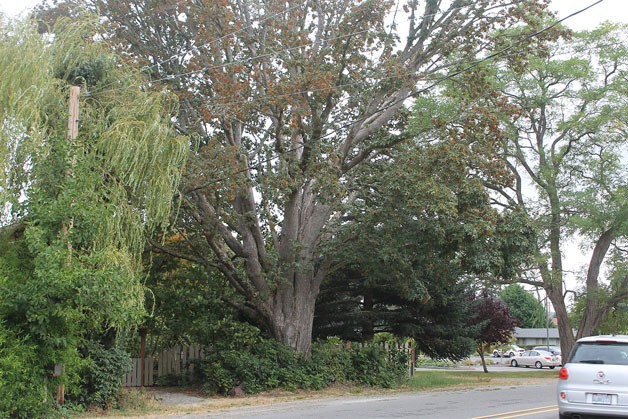A 50-foot-tall diseased and dying maple tree on Third Street that poses a risk to a nearby Langley household as well as pedestrians will be chopped down later this month.
Pioneer Tree Service & Landscaping, Inc. of Oak Harbor, which was contracted by the city to evaluate the tree for its hazard potential, recommended its removal in a report due to decayed wood and dead branches throughout its canopy and root system and being located in a high-use area. The tree and its dying limbs lean over a family’s house, utility pole, parking area and main roadway.
An arborist will cut it down sometime in mid-September. The tree is located near St. Hubert Catholic Church.
“Remove the tree as soon as applicable,” the arborist’s report said. “Large trees with severe internal rot, such as this one, may fall with little warning, injuring people and causing extensive property damage.”
The family that lives near the tree, who declined to be named, first reported the tree as a safety concern in June. One of the factors that prompted them to speak up occurred a few months ago when a large tree limb fell on their fence without obvious cause — there was no wind or notable weather. They were first warned about the tree by the previous homeowner.
City Public Works Director Stan Berryman investigated the tree and its location and determined it to be within city limits. He contacted Pioneer Tree on June 7 to evaluate the tree for its hazard potential. The inspection, conducted by Elijah Walton, included a visual examination as well as an invasive procedure which involved taking core samples from the north, west, south and east sides of the tree. The samples showed spongy, soft wood that was the result of decay, the report said. Fungus and black root rot were also found. The fungus caused by G. applanatum infects the roots and lower trunk, attacks the lower heartwood and can damage structural integrity of the tree in advanced stages, making it prone to being uprooted or broken by wind. The report said the black rot attacks a tree near or at ground level and increases decay while weakening roots and the “anchor area” of the tree. Berryman concurred with the arborist’s report.
“If it’s a dead tree, it poses a hazard of falling over,” Berryman said.
Tree removal has drawn concern from Langley residents in the past. Large trees being chopped down have spurred public debate and led to the development of the city’s draft tree ordinance. The rules govern basic protections for trees of a certain diameter, but they have yet to be completed.
Lorinda Kay, Langley Main Street Association Program Manager, said the association has been very active in planting trees along Second Street and replacing those removed in the past on First Street. She said that while the association is pro trees, the city is making the right decision in cutting down the tree.
“Of course we love trees, but not to the point where they become dangerous,” Kay said. “We can’t have dangerous trees in the city.”
A large evergreen tree at Boy and Dog Park is also being considered for removal. At a city council meeting in June, Berryman said the tree’s roots were causing damage to Village Pizzeria. Pioneer Tree was hired to evaluate the tree’s threat to the building and its general condition. The tree is within the boundary of the shoreline management program and required evaluation by an expert.
Berryman said the arborist, Walton, has made two trips to inspect the tree. The arborist is currently looking for ways to remove parts of the tree without killing it or making unsafe.
“Not a complete removal, but a removal enough to stabilize the building and save some of the tree,” Berryman said.



